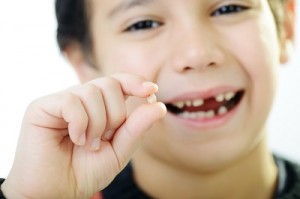Baby Tooth Trauma
 By Dr. Stephanie Chen, Chen Pediatric Dentistry
By Dr. Stephanie Chen, Chen Pediatric Dentistry
Getting calls from panicked parents about trauma to their children’s teeth is common. Pediatric dental trauma affects 30 percent to 40 percent of all children. Whether caused by a sports-related accident or a tumble, impact can cause injury to the tooth or completely knock it out. How tooth trauma is treated varies upon whether the teeth are primary or permanent.
When a child’s baby tooth is lost due to trauma, some parents opt to not worry about it since, “he was going to lose that tooth anyway.” Conversely, some parents tend to not worry if the tooth is still in place. This is understandable since teeth are the most visible part of one’s smile, but it’s important to understand teeth are only part of the concern.
Dental trauma can include damage to the area around the teeth; for example, the tissue between the upper front teeth that connects the lip to the gums (called the maxillary frenum) can tear. If this happens, apply firm pressure with gauze to lessen bleeding and call a dentist for further evaluation. An injury of this kind generally fixes itself and usually does not require treatment.
After a baby tooth is injured, a dentist’s strategy for treatment is to minimize the potential for damage to the permanent tooth developing beneath. Dental trauma can cause complications to the developing permanent tooth, such as discoloration to the permanent tooth, crown/root malformation or a disruption in the pattern or sequence of the tooth eruption.
What You Need to Know About Types of Trauma
Treatment for a chipped baby tooth depends on the extent of damage.
- A fracture that involves the enamel (outer layer of the tooth) may need to be smoothed.
- If the fracture involves the enamel and dentin (second layer) and a large portion of the tooth is missing, the dentist may need to place a dental composite.
- A fracture that involves the nerve (pulp exposure), may require nerve treatment to the tooth or possibly a dental extraction.
When a baby tooth is bumped and appears to be in the same position, this is called a dental concussion. Though it may not wiggle or bleed, it may be tender to touch. Usually no treatment is needed and observation is recommended.
Injury can cause a tooth to become loose with some bleeding from the gums. If the tooth is not out of its position, this injury is called a subluxation injury. A dental x-ray is recommended to look for signs of a fracture in the root or displacement of the root. A dental x-ray is always good to have as a baseline to compare for further follow-up.
A tooth that is bumped and appears to be in a different position is called a luxation injury. The tooth can be partially displaced from the dental socket, appear longer than it was before and be excessively loose. The tooth can also be displaced in a forward or backward position (lateral luxation) without being loose. This type of injury may push the baby tooth root into the developing permanent tooth and cause damage to the permanent tooth. Treatment of these conditions depends upon the degree of trauma and the child’s ability to cope with discomfort.
In the worst-case scenario, a baby tooth is completely out of the dental socket. In this case a dental x-ray is recommended to ensure that the tooth is not pushed up into the bone (called an intrusion injury). We do not typically recommend re-implant of this tooth due to the possibility of damaging the developing permanent tooth.
When your child experiences tooth trauma it can be stressful for everyone. Contact your child’s dentist to determine treatment. Know that treatment can vary from each situation and that the ultimate outcome is to have the best prognosis for the developing permanent tooth.
Dr. Stephanie Chen has been practicing pediatric dentistry over 20 years. She received her dental degree at the Ohio State University and her pediatric specialty degree at the University of North Carolina at Chapel Hill. For questions, call Chen Pediatric Dentistry at 704-365-0888.
This blog was produced in partnership with Charlotte Parent. Click here for the original post and other parenting resources.













